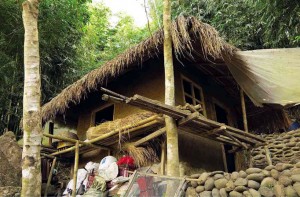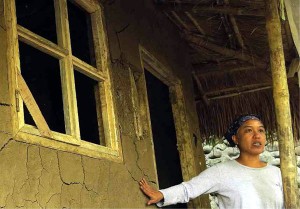Eco-friendly earth house rises in La Union village

THIS HOUSE, built from mud and other earth-friendly materials, blends well with the rustic environment of the village of Pideg in Tubao, La Union. PHOTOS BY EV ESPIRITU
A small house built on the side of a hill has aroused the curiosity of residents in a farming village in Tubao town in La Union province. Not only because it is unique and simple, but it is also made of mud.
“It’s an earth house,” says Cyrene Reyes, who, along with her partner, Carol Galvez, began building the house last year in the village of Pideg.
The house, actually a tool shed with a bed space, has a floor area of nine square meters, a concrete floor and a cogon roof. Its walls are coated with mud.
It stands on the “living zone” of a 9,000-square-meter farm known as The Pitak Project. Pitak is Ilocano word for mud.
“It’s our first project, a trial, because we do not have any experience in building construction,” says Reyes, who used to work in a nongovernment organization based in Baguio City. She and Galvez intend to build a bigger “main house” in the farm using mud bricks.
Article continues after this advertisementThe way the house was built is no different from the conventional: laying the foundation, erecting the posts, installing the roof frame and propping the walls.
Article continues after this advertisementWith the help of a friend who knows carpentry, Reyes began making the skeletal house in October last year.
Local materials

Cyrene Reyes, one of the proponents of The Pitak Project, explains the benefits of building and living in an earth house. PHOTOS BY EV ESPIRITU
Fortunately, she says, all the materials she needed were locally available. The farm is located in a sloping forested area of the village with abundant bamboo variety called bolo.
“We have a good quality of clay here. We also have a creek nearby, where we got the rocks and sand we needed,” Reyes says. “In natural building, as much as possible, you get your materials locally.”
When it was time to slather the walls with mud, Reyes sought the help of villagers. “The bayanihan spirit is still strong here. That’s why many people came to help, especially women and children,” she says.
The villagers helped mix the mud with sand and straw with their bare feet, and plastered them on the bamboo wall frames with their bare hands.
“This is just the first layer. We still have to put on the second layer of mud and then we will apply lime plaster for the finishing,” Reyes says. “Then, because we experience torrential rains, we will also do some waterproofing.”
Recycling
The front wall is also adorned with colored bottles, creating a stained-glass effect. “By using these bottles, you promote recycling. Natural light can also pass through them,” Reyes says.
With the mud walls, she says, the temperature inside the house is colder because bottle is a good insulator.
“They also say that using mud in walls is healthy because it releases a certain kind of ion that a person needs,” she says.
Another consideration, she says, is the fact that the country lies on an earthquake belt. “When it shakes and the wall falls on you, you are not going to die,” she says.
Alvin Bigay, a civil engineer who heads Pangasinan’s housing and urban development coordinating office, says that although earth houses are cheaper to build and environment-friendly, one cannot just put them up anywhere.
“These should be built in elevated areas and in places where they can be shielded from strong winds and rains,” Bigay says.
He says people, who are used to conventional types of construction materials, also need to be educated about it. “Personally, earth houses are fine with me. But then again, it has to be socially acceptable,” he says.
Alternative shelter
Reyes says that what she wants to promote is an alternative shelter that everybody can build in the communities. “It is affordable, at the same time, sustainable, environment-friendly,” she says.
When she decided to settle in her farm in Tubao, she wanted to show that one can live by being self-reliant. In her farm, she grows organic rice and vegetables and raises native chickens and ducks.